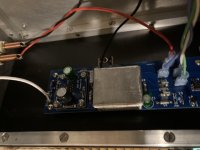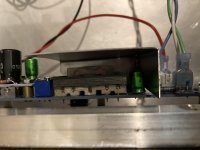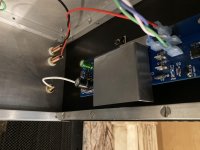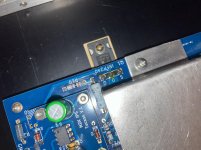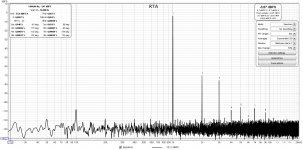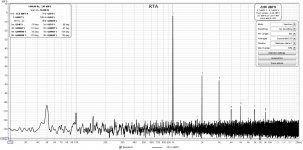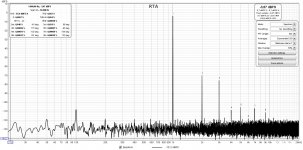this is the one that did not make any difference. I had virtually no noise to begin with. This is 22 ga steel super simple and it does not hug the edcor quite so much.
Only way to test this is to remove the toroid case and see what the effect is. Installing that made a HUGE difference in sound quality. That is also 2mm steel case from antek.
Only way to test this is to remove the toroid case and see what the effect is. Installing that made a HUGE difference in sound quality. That is also 2mm steel case from antek.
Attachments
Ok, I will find out to get some boards......should be easy as the Gerber is available. I am from Denmark (Europe) and have not ordered any components and I also need to perform some matching of the J113.....so may take a while before I have finished boards.
I was set to match fets yesterday, but the 1 uF caps I ordered were non polar... ordered appropriate ones, but this might be a beach weekend. Depends on Sally.
Good luck with your build.
@grataku, did I understand correctly that putting the power toroid in steel case made a huge difference for you, and after that a small steel case around the Edcor did not make any difference that you could hear?
yes
When you do these experiments with shielding it is a big help to have distortion measurement running (e.g. Focusrite (sound card), REW, M2X) in a closed loop. Then you can see exactly which effect your shielding has on distortion / noise.
I agree, unfortunately I have no such equipment.
It's very much an experiment without control at this point, but then again if I can't hear the difference it doesn't really matter.
I have no hum at all, and do not have the Edcor shielded. It wasn't luck though as I gave a lot of thought to layout because of all your input here. I'm from the the KISS school, if you can prevent something from happening in the first place, you don't have to patch it later. I have some pretty good gear for testing now, but haven't even plugged it in and learned how to use it lol. This winter, I shall do so, but with not to get perfect forms or this or that value. "perfect." I'm going to use it to learn what those values look like on amplifiers, speakers, chain that appeal to me. I could give a damn if it's something that others scoff at. It's all about you and your reaction to what you hear.
I've heard some very high end equipment and it sounded devoid of life to me. I couldn't really get my mind around what I did not like, but I just didn't feel "It" whatever that is. I also think "It" is different for every pair of ears and brain.
One thing I want to do it get the gear on as many systems as possible and see if I can find a correlation to what I like and don't. That could sure save some trial and error when looking to take on new projects.
JT
EDIT: PS, I finally got the lab in shape, put in a whole house gen, re-sodded the yard, rebuilt the truck engine, put in a state of the art security system, which included 50mm turrets and Claymores.
I dusted off the second channel of the mono build I put on hold 2 months ago. I did some minor metal work today, but am very excited to get back to building!!
I've heard some very high end equipment and it sounded devoid of life to me. I couldn't really get my mind around what I did not like, but I just didn't feel "It" whatever that is. I also think "It" is different for every pair of ears and brain.
One thing I want to do it get the gear on as many systems as possible and see if I can find a correlation to what I like and don't. That could sure save some trial and error when looking to take on new projects.
JT
EDIT: PS, I finally got the lab in shape, put in a whole house gen, re-sodded the yard, rebuilt the truck engine, put in a state of the art security system, which included 50mm turrets and Claymores.
I dusted off the second channel of the mono build I put on hold 2 months ago. I did some minor metal work today, but am very excited to get back to building!!
Last edited:
I like to measure everything. I also feel confident when both M2X channels measures equal has has exact same distortion profile.
If you have speakers with sensitivity about 92 - 98 dB and has no audible hum it is quite good I think without shielded Edcor. The trick is to avoid the magnetic field from power transformer to be picked up by Edcor. During measurement I tried to put my finger on the shield on Edcor and 50 Hz raised to astronomic levels. Same applies to the coupling capacitor.
If you have speakers with sensitivity about 92 - 98 dB and has no audible hum it is quite good I think without shielded Edcor. The trick is to avoid the magnetic field from power transformer to be picked up by Edcor. During measurement I tried to put my finger on the shield on Edcor and 50 Hz raised to astronomic levels. Same applies to the coupling capacitor.
Nothing wrong with measuring everything as long as you don't tie what looks good to what sounds good. Speakers are Tekton DI, so yes, very sensitive.
I love your meticulousness MEPER, just don't get trapped to into thinking what looks good on a scope translates into what sounds good. Offset of course and yes, both sides should have similar distortion, but it's never going to be perfect and in fact, my 2 ears are quite different and I have found that the optimal for one is not the best for the other. This comes in to play more with phones, but to some degree with speakers as well.
Sometimes I think we would be better of if we just left the analyzers on the bench and let our ears tell us the story... no, that's wrong. I 100% think that;s what we should do. I can hear the hum... yup, fix that. I don't need a meter to read 0.0v. If I can't hear it then what does it matter? Case in point, lots of people do a test, myself included, stick you head in the speaker, can you hear a hum? Who cares? Do you listen with your head stuffed in the speaker? NO, then what's the point other than you can say my **** is dead flat on dc offset.... There's not one thing wrong with wanting it 0.0v, but if I can't hear it at my chair, then it doesn't concern me. Many times to makes things, "exact" you may lose some of the magic.
Just sayn
JT
I love your meticulousness MEPER, just don't get trapped to into thinking what looks good on a scope translates into what sounds good. Offset of course and yes, both sides should have similar distortion, but it's never going to be perfect and in fact, my 2 ears are quite different and I have found that the optimal for one is not the best for the other. This comes in to play more with phones, but to some degree with speakers as well.
Sometimes I think we would be better of if we just left the analyzers on the bench and let our ears tell us the story... no, that's wrong. I 100% think that;s what we should do. I can hear the hum... yup, fix that. I don't need a meter to read 0.0v. If I can't hear it then what does it matter? Case in point, lots of people do a test, myself included, stick you head in the speaker, can you hear a hum? Who cares? Do you listen with your head stuffed in the speaker? NO, then what's the point other than you can say my **** is dead flat on dc offset.... There's not one thing wrong with wanting it 0.0v, but if I can't hear it at my chair, then it doesn't concern me. Many times to makes things, "exact" you may lose some of the magic.
Just sayn
JT
Last edited:
I put my head into the speakers and if I can hear any hum I want to fix it 
I know if I measure something "bad" I need to fix it.....or I will think about it every time I listen. If I know everything measures perfect I listen more relaxed and I concentrate on the music. There is much psychology in music listening. Another aspect of measurements is learning.
About DC offset.....it is very temperature dependent and also depends in some degree on line voltage......so here I am satisfied to be within 50 mV. If you try to get inside 5 mV and get there.....then if you check one week later you may find now it says 20-30 mV.....
I know if I measure something "bad" I need to fix it.....or I will think about it every time I listen. If I know everything measures perfect I listen more relaxed and I concentrate on the music. There is much psychology in music listening. Another aspect of measurements is learning.
About DC offset.....it is very temperature dependent and also depends in some degree on line voltage......so here I am satisfied to be within 50 mV. If you try to get inside 5 mV and get there.....then if you check one week later you may find now it says 20-30 mV.....
@MEPER,
I don't think a multimeter doesn't have the sensitivity to detect a few mV of ripple, maybe an analog scope?
Anyways, I can't really hear any sizable hum with the ear at the woofer or the tweeter.
What I experienced with the transformer case was a completely different high frequency response and sound like going from a regular driver to a compression loaded driver. Quite amazing difference and totally unexpected suggesting that the mains transformer was somehow coupling to the EDCOR and distorting/attenuating it's mid/hi response...but I am talking nonsense..

Having said that, there are changes I want to make to the PS since I am not entirely happy with it.
I don't think a multimeter doesn't have the sensitivity to detect a few mV of ripple, maybe an analog scope?
Anyways, I can't really hear any sizable hum with the ear at the woofer or the tweeter.
What I experienced with the transformer case was a completely different high frequency response and sound like going from a regular driver to a compression loaded driver. Quite amazing difference and totally unexpected suggesting that the mains transformer was somehow coupling to the EDCOR and distorting/attenuating it's mid/hi response...but I am talking nonsense..
Having said that, there are changes I want to make to the PS since I am not entirely happy with it.
I put my head into the speakers and if I can hear any hum I want to fix it
I know if I measure something "bad" I need to fix it.....or I will think about it every time I listen. If I know everything measures perfect I listen more relaxed and I concentrate on the music. There is much psychology in music listening. Another aspect of measurements is learning.
About DC offset.....it is very temperature dependent and also depends in some degree on line voltage......so here I am satisfied to be within 50 mV. If you try to get inside 5 mV and get there.....then if you check one week later you may find now it says 20-30 mV.....
Copy that!
Sometimes I break it just to be able to go in and fix it...LOL
@MEPER,
I don't think a multimeter doesn't have the sensitivity to detect a few mV of ripple, maybe an analog scope?
Anyways, I can't really hear any sizable hum with the ear at the woofer or the tweeter.
What I experienced with the transformer case was a completely different high frequency response and sound like going from a regular driver to a compression loaded driver. Quite amazing difference and totally unexpected suggesting that the mains transformer was somehow coupling to the EDCOR and distorting/attenuating it's mid/hi response...but I am talking nonsense..
Having said that, there are changes I want to make to the PS since I am not entirely happy with it.
My DMM has a 0.1 mV resolution in AC mode. So if it shows 0.0 mV I assume that I have less than 50uV of noise. Also my DMM is a true RMS DMM. In your case a distortion measurement will be best like the image attached of one channel of my M2X. Oscilloscopes exists that has 100 uV pr. div. sensitivity but most normal is 1-2 mV / div. if you use a x1 probe. And you should be able to see "something". It is never easy to measure these weak signals and be sure you measure the amp and not something from environment. For my distortion measurement I made an interface box that goes from banana plugs to a 6.8R power resistor and from there to RCA with a divider network so signal fits to the Focusrite sound card input level. Then I can measure amp when it delivers like say 1-4 Watts.
Attachments
To show how tricky noise measurements can be I have attached both L and R channel measurements. I have mono blocks and I have tried to make an exact mirror of the mono blocks. But not all components is "mirrored" like IEC and PSU print and also M2X PCB is not an exact mirror of the other. Input board is not mirrored also and Edcor's. So it can't be a 100% mirror. Also the toroid transformers may not have exact same hum field distribution.
So one channel shows more 50 Hz noise and a bit less 100 Hz noise than the other. But levels are still quite low and I am happy with that distortion profile looks about equal on both channels. Also total THD and N is quite equal. So all in all I am happy with my build. The amps outputs 4.7V RMS into 6.8R in these measurements.
What I think I noticed was that with small signal levels the amp is slightly 3rd harmonic and shift to slightly 2nd harmonic when amp delivers more power. But I did not spend time on low level measurements which I should probably do also. Also a check how amp performs at high frequency could be interesting.
So one channel shows more 50 Hz noise and a bit less 100 Hz noise than the other. But levels are still quite low and I am happy with that distortion profile looks about equal on both channels. Also total THD and N is quite equal. So all in all I am happy with my build. The amps outputs 4.7V RMS into 6.8R in these measurements.
What I think I noticed was that with small signal levels the amp is slightly 3rd harmonic and shift to slightly 2nd harmonic when amp delivers more power. But I did not spend time on low level measurements which I should probably do also. Also a check how amp performs at high frequency could be interesting.
Attachments
I also have a couple of those which are good if you need more DMMs for e.g. combined bias/offset adjust. I got my in Lidl. 0.1 mV resolution is quite normal if you pay around 100 - 150 USD 
I have considered a bench model which goes lower......but they are more expensive.
I have considered a bench model which goes lower......but they are more expensive.
- Home
- Amplifiers
- Pass Labs
- The diyAudio First Watt M2x
